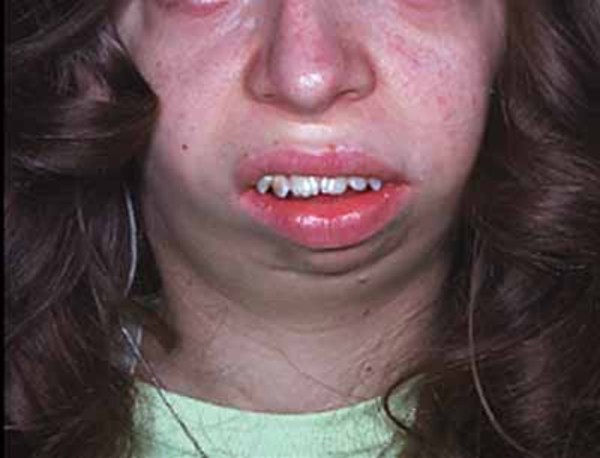Auriculo-condylar Syndrome
Auriculo-condylar syndrome. Prominent constricted ears with malformed condyle of the the. Alexis Melton from Seattle was born with the life-threatening auriculo-condylar syndrome which caused her to be born with an underdeveloped lower jaw. Abstract We report on a patient born to normal and nonconsanguineous parents and presenting with strikingly malformed ears abnormalities of the condyle of the mandible micrognathia small mouth and cleft uvula.
Its inheritance follows the autosomal dominant pattern. Auriculo-condylar syndrome ACS is a rare syndrome with an autosomal dominant pattern of inheritance. Auriculocondylar syndrome ARCND is an autosomal dominant disorder of the first and second pharyngeal arches and is characterized by malformed ears question mark ears prominent cheeks microstomia abnormal temporomandibular joint and mandibular condyle hypoplasia summary by Masotti et al 2008.
Auriculo-condylar syndrome ACS OMIM 602483 an autosomal dominant disorder was first described by Jampol et al 1 who reported relatives from five generations of. 2002 WileyLiss Inc. These mutations likely alter the structure of the inhibitory alpha subunit.
Auriculo-condylar syndrome ACS is characterized by typical ears malformation so-called question mark ears prominent cheeks microstomia and abnormality of the temporomandibular joint and. Very few reports describe this syndrome in the literature and all focus on diagnosis. At least two mutations in the GNAI3 gene have been found to cause auriculo-condylar syndrome a disorder that primarily affects the development of the ears and lower jaw mandible.
54 rows Definition A rare disorder that presents with bilateral external ear malformations question mark ears mandibular condyle hypoplasia microstomia micrognathia microglossia and facial asymmetry. Auriculo-condylar syndrome ACS OMIM 602483 is a rare She had a round face with puffy cheeks microstomia accentuated autosomal dominant disorder firstly described by Jampol et al. The latter has also been reported in isolation.
The identified mutations change single protein building blocks amino acids in the inhibitory alpha subunit. Journal of Cardiopulmonary Rehabilitation and Prevention. We discuss the findings in our patients in relation to those in the literature.
The normal development of the first and second bran- Jampol M Repetto G Keith DA Curtin H Remensnyder J Holmes LB. Both familial and individual cases are reported in the literature.
Auriculo-condylar syndrome ACS OMIM 602483 is a rare She had a round face with puffy cheeks microstomia accentuated autosomal dominant disorder firstly described by Jampol et al.
Auriculo-condylar syndrome ACS OMIM 602483 is an autosomal dominant condition with marked phenotypic variability. Abstract We report on a patient born to normal and nonconsanguineous parents and presenting with strikingly malformed ears abnormalities of the condyle of the mandible micrognathia small mouth and cleft uvula. Auriculo-condylar syndrome ACS is characterized by typical ears malformation so-called question mark ears prominent cheeks microstomia and abnormality. Journal of Cardiopulmonary Rehabilitation and Prevention. Auriculo-condylar syndrome is a condition that affects facial development particularly development of the ears and lower jaw mandible. The latter has also been reported in isolation. We discuss the findings in our patients in relation to those in the literature. Its inheritance follows the autosomal dominant pattern. Further evidence for a new disorder.
The normal development of the first and second bran- Jampol M Repetto G Keith DA Curtin H Remensnyder J Holmes LB. Auriculo-condylar syndrome ACS is characterized by typical ears malformation so-called question mark ears prominent cheeks microstomia and abnormality. On the other hand although findings vary 1998. Further evidence for a new disorder. Auriculocondylar syndrome ARCND is an autosomal dominant disorder of the first and second pharyngeal arches and is characterized by malformed ears question mark ears prominent cheeks microstomia abnormal temporomandibular joint and mandibular condyle hypoplasia summary by Masotti et al 2008. Very few reports describe this syndrome in the literature and all focus on diagnosis. The ears were low-set 1998.








































Posting Komentar untuk "Auriculo-condylar Syndrome"